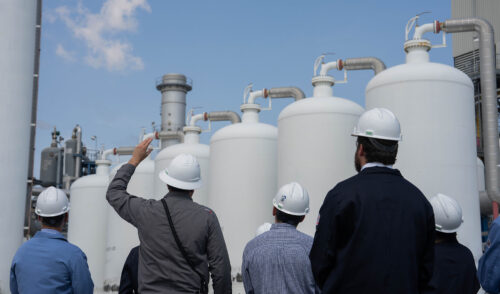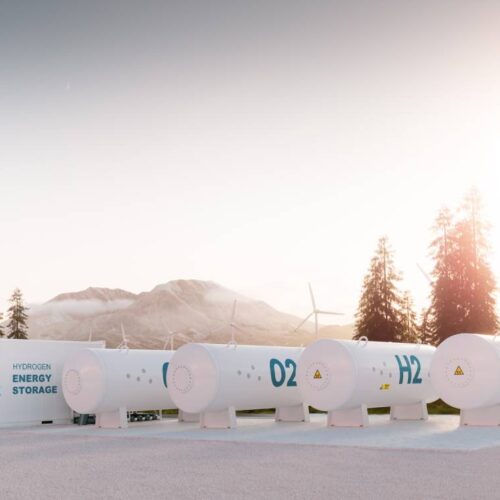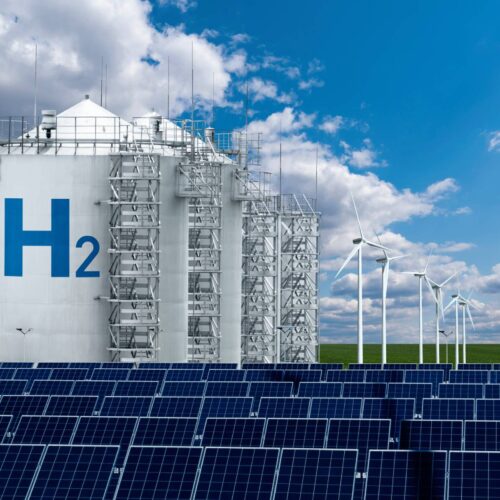
Q&A: Why We Need Hydrogen Hubs
An interview with RMI Principal Nabil Bennouna about the role regional clean hydrogen hubs will play in advancing the clean energy transition.
Last year, the US Department of Energy selected seven regional clean hydrogen hubs to receive $7 billion in federal funding. Funded by the Bipartisan Infrastructure Bill, the hubs are a part of the Biden administration’s efforts to jump-start the market for low-cost clean hydrogen, which it sees as key to achieving climate goals.
Building on more than fifteen years of experience in the execution of large-scale infrastructure projects and corporate strategy, Nabil Bennouna, an energy and finance expert on RMI’s Climate Aligned Industries Team, focuses on catalyzing the economy for clean hydrogen, which has low or zero carbon emissions associated with its production, storage, and distribution. To advance this market, Nabil provides advisory support to regional hydrogen hubs, works to develop international clean hydrogen trade, and designs novel counterparty arrangements between supply, demand, and finance to facilitate project development.
Nabil thinks of hydrogen hubs as more than just pipes and wires: hubs will be a layered system of human interactions, economic policy, and cross-regional collaboration. I sat down with him to get his take on hydrogen hubs, why they are needed, and what a successful rollout could look like.
What are hydrogen hubs?
Hydrogen hubs are organized networks where people and facilities involved in making and using clean hydrogen work together efficiently. These hubs aim to speed up the production and usage of clean hydrogen by taking advantage of the benefits that come from having everything closely connected in an industrial cluster.
But they are not only a web of shared physical structures connecting hydrogen suppliers to users, they are also something more intangible: a platform of information that will align common infrastructure requirements, shape basic terms, create resource exchanges, optimize efficiencies, and leverage competitive advantages to accelerate the clean hydrogen industry.
Hubs concentrate opportunity and distribute risk, allowing producers and consumers to expand their supplier and purchaser base, splitting and diversifying risk across several market participants to help ensure that supply chains maintain resilience as underlying technologies mature.
Why are hydrogen hubs part of the US strategy for the energy transition?
Clean hydrogen is a promising lever to decarbonize some of the trickiest and most essential parts of our economy, such as chemicals, shipping fuel, fertilizer, and steel production. But the fact is, clean hydrogen isn’t currently widely available nor cost effective enough to take on this role in the energy transition. To achieve decarbonization ambitions, we urgently need investment in project development.
To finance a project, investors need to understand that the full supply chain is built out. In other words, projects can only attract investors if they prove someone is going to buy their products at the scale they plan to produce them — that’s business model 101. In the case of a nascent, complex commodity like clean hydrogen, building out a new supply chain takes time. But to meet our climate objectives, we don’t have time to wait around. Hubs jump-start supply chain development by concentrating infrastructure and markets in a single geography.
The hydrogen hubs are the start of the beginning, a pathway for clean hydrogen projects to go from conceptual to feasible to operational.
Concretely, how do federally supported hubs help achieve this?
Converting entire supply chains to run on hydrogen will be expensive, particularly for the first few projects before technology has matured.
Hubs can be structured as public–private partnerships, granting them the unique position to unlock vital fund matching from federal and state governments while also enticing first-mover private sector capital. This is coupled with the fact that stacking together firm commitments across a diverse set of hubs participants lends credibility to the vision of a well-functioning clean hydrogen ecosystem, also stimulating investment.
Individual projects can find other ways to access capital, but convincing mainstream investors that investment is flowing into a region from several sources is a really effective way to drive down perceived risk and in turn, long-term costs.
Why are the hubs important for industrial decarbonization more generally, not just for hydrogen but for other emerging low-emissions fuels and feedstocks?
RMI believes that the majority of industrial decarbonization projects will occur in clusters or “hubs” – not just for hydrogen but for all types of commodities.
When it comes to decarbonization projects, hubs are crucial because of their unique ability to geographically concentrate the development of low-emissions fuels and feedstocks with the industrial consumers who can use them to decarbonize industry, ranging from steel and aluminum mills to cement plants, chemical refineries, and so much more. For example, the Kalundborg Eco Industrial Park, a hub connecting nine companies in Denmark, is a waste-sharing network, in which one manufacturer’s waste provides a resource for another: power plants give excess heat to factories, waste processing plants transfer biogas to refineries, and pharmaceutical manufacturers donate waste to farmers for use in fertilizer. By connecting these processes in a hub, the companies are reducing carbon dioxide emissions, water, and energy use.
Hubs are not exclusive to one decarbonization vector. Instead, they are an organizational framework that can be used to turn local decarbonization successes into global impact.
Why can’t projects use existing hydrogen infrastructure and markets to reach consumers and attract investment?
It’s true that fossil-based hydrogen has a well-developed supply chain in the United States – approximately 10 million metric tons is produced annually and consumed mainly in the chemicals, fertilizer, and refining industries. There are two things that make clean hydrogen different, however: the number of new kinds of industrial consumers for it, and the sheer volume that we’ll need of the product to reach climate goals.
Take a step back and think about all the sectors that need clean hydrogen to decarbonize: not just fertilizer but steel, shipping, aviation, and potentially more. These sectors don’t necessarily have a common supply chain element — an airline doesn’t buy jet fuel from the same place that a fertilizer producer buys its natural gas for ammonia — but they do share a common goal of decarbonizing their operations. Because these sectors aren’t naturally using the same supply chain, we need to devote time and resources to connect them. Regional infrastructure clusters like hydrogen hubs will facilitate that.
The Department of Energy has set the goal of producing 50 million metric tons of clean hydrogen fuel by 2050. To ensure these investments happen now and happen successfully — in other words, achieve the decarbonization urgently needed — we need hubs.
This must happen globally, too. Worldwide, we’ll need in the order of 300 sustainable aviation fuel plants, 200 zero-emissions deep-water vessels, seven million net-zero trucks, 100 net-zero steel plants, 60 zero-emissions ammonia plants, 40 new net-zero aluminum facilities, and 20 net-zero cement plants with carbon capture by 2030 to meet sector-specific decarbonization goals. Most of these projects will happen in hubs.
The hydrogen hubs announcement includes detailed guidance on the community benefits requirements that each hub must meet prior to receiving funding. What are the broader implications of including community benefits requirements in a federal funding opportunity this large?
The clean regional hydrogen hubs and their community benefits plan requirements facilitate information sharing, balance the needs of local communities, and help projects reach their greatest potential to reduce emissions.
Heavy industry facilities are often located in or near marginalized low-income communities, and when it comes to project development, residents of these communities are not always invited to provide input to shape the policies and practices that impact them. This needs to change. To help developers initiate meaningful, two-way community engagement, RMI has published case studies and best practices from advising developers of the DOE’s $7 billion Regional Clean H2Hubs program.
Meaningful two-way community engagement can lead to mutually beneficial relationships between project developers and local communities, and incorporating community input in both community benefits and project design will be critical to accelerating and executing a just energy transition in the United States.
What would effective implementation of the hydrogen hubs look like?
In this arena, we have a lot to learn from Europe. The European Hydrogen Backbone (EHB) initiative, a coordinated approach to identifying hydrogen infrastructure needs, has found success in early-stage deployment plans, shared visions focusing on the most needed infrastructure corridors, and systemic approaches to planning that engage multiple stakeholders to better understand what an optimal rollout looks like.
Inspired by the EHB, Guidehouse and RMI are initiating a North American Hydrogen Backbone collaborative to create a framework for infrastructure development, drawing from the experience of Europe to ensure hydrogen hubs can bypass midstream barriers and focus on growing supply and demand-side adoption.
I think a critical objective is that “hubbing up” will spur coordination, especially on elements like infrastructure. Hydrogen hubs are trying to avoid scenarios in which two pipelines get built in one area where only one is needed or zero pipelines get built in an area where one is desperately needed. The long-term success of hubs is foundationally reliant on effective communication to sequence and plan projects in a coordinated manner.

